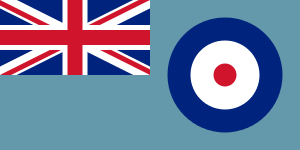RAF Hereford
Credenhill Barracks | |||||||
|---|---|---|---|---|---|---|---|
| Near Credenhill, Herefordshire, in England | |||||||
 Credenhill Barracks RAF Hereford within Herefordshire | |||||||
| Coordinates | 52°05′06″N 002°47′42″W / 52.08500°N 2.79500°WCoordinates: 52°05′06″N 002°47′42″W / 52.08500°N 2.79500°W | ||||||
| Site information | |||||||
| Owner | Ministry of Defence | ||||||
| Operator | British Army | ||||||
| Site history | |||||||
| Built | 1999 | ||||||
| In use | 1999 - Present | ||||||
| Battles/wars | Second World War | ||||||
| Airfield information | |||||||
| |||||||
Royal Air Force Station Hereford or RAF Hereford, and also known as RAF Credenhill, was a non-flying station of the Royal Air Force situated in the village of Credenhill near Hereford. It was commissioned in 1940 and served as home for a range of training schools from 1940 until closure in 1999. RAF Hereford was home to Administrative Apprentice training until the final entry (330) graduated and passed out in August 1973 following which the station continued to provide trade training to adult entrants to the RAF and 'in service' junior command and leadership / promotion training until 1999. The station was subsequently redeveloped for use by the British Army and established as depot for the Special Air Service.
History
World War 1
After the outbreak of World War 1, the Ministry of Munitions were looking to create a number of Royal Ordnance Factory munitions production facilities quickly and cheaply. In 1912 Herefordshire County Council had bought 185 acres (75 ha) of the former Rotherwas estate from the Lubienski-Bodenham family, that overlooked by Dinedor Hill and was bordered by the Wye meadows.[1][2]
A site of 100 hectares (250 acres) was acquired by the Ministry on 15 June 1916, located at Lower Bullingham just south of Hereford on the junction of the Welsh Marches Line and the Hereford, Ross and Gloucester Railway. Laid out to a standard design, ROF Rotherwas encompassed:[1][2]
- 27 miles (43 km) standard gauge railway
- 3 miles (4.8 km) of roads
- 9 miles (14 km) of guard fence
- 10 miles (16 km) of footpaths and sentry paths
- 370 buildings varying in floor area. Like a typical munitions facility, the buildings were widely spaced on safety reasons, to avoid complete destruction of the facility in case of an explosion
For storage purposes, the ROF also acquired railway-connected lands at Credenhill.[1][2]
All components were produced elsewhere, with the facility responsible for final production: inserting explosive into shells, and fitting detonators. Shell filling began on 11 November 1916, with both Lyddite and Amatol explosives being used in production. From June 1918, supplied with dichloroethyl sulphide by the National Smelting Company at Avonmouth Docks, the facility produced mustard gas shells.[3][4] By the end of WW1, the average output of shells from the facility was 70,000 per week.[1][2][5]
World War 2
At the outbreak of World War 2, the same site at Credenhill was leased from the farmer land owner. This housed:
- No. 11 School of Technical Training from 15 June 1940 until 30 September 1945.[6]
- School of Torpedo Maintenance from 1942 until 1946.[6]
- No. 7 Mobile Parachute Servicing Unit from 17 April 1944 to February 1945.[6]
- HQ, No. 24 Group from September 1944 until December 1944.[6]
- No 50 Gliding School (Mar 1944 - Jan 1946)*
- The Air Crew Officers School from 3 May 1944 until 1 November 1944.[6]
- No. 1 Air Crew Officers School from 1 November 1944 until 1 May 1946.[6]
- No. 2 S of A T (School of Administration training.) May 1948.[6]
- No. 533 Sqn RAF Regiment starting from 1 July 1952.[6]
- No 11 School of Technical Training (15 Jun 1940 – 30 Sep 1945)
- WRAF Depot / WRAF clerical trades training school.
- RAF/WRAF catering trade training school (The Royal Air Force School of Catering).
- No. 3 School of Technical Training from April 1959 until 17 May 1974).[6]
- Administrative Apprentice Training School from 1953 to August 1973 culminating in the graduation of the final App. Admin entry (#330).

RAF Chef Apprentices 1964 to ?
Current use
No. 658 Squadron AAC has been posted here.[7] 22 Regiment, Special Air Service is also based here.
References
- ↑ 1.0 1.1 1.2 1.3 "Royal Ordnance Factory Rotherwas". Herefordshire County Council. Retrieved 13 May 2014.
- ↑ 2.0 2.1 2.2 2.3 Edmonds, John (2004). The History of Rotherwas Munitions Factory, Hereford. Logaston Press.
- ↑ Haber L.F. (1986). "10". The Poisonous Cloud. Oxford University Press. ISBN 9780198581420.
- ↑ Ian F.W. Beckett. "The Home Front 1914-1918: How Britain Survived the Great War". Retrieved 13 May 2014.
- ↑ "Rotherwas Ordnance, Hereford". archaeologists.tv. Retrieved 13 May 2014.
- ↑ 6.0 6.1 6.2 6.3 6.4 6.5 6.6 6.7 6.8 "RAF Hereford (Credenhill)". Air of Authority - A History of RAF Organisation. Retrieved 9 April 2012.
- ↑ Gary Parsons (January 2014). "News briefs". AirForces Monthly (Stamford: Key Publishing): pg.7.
External links
| ||||||||||||||||||||||||||||||||||||||||||||||||||||||||
| ||||||||||||||||||||||||||||||||||||||||||||||
